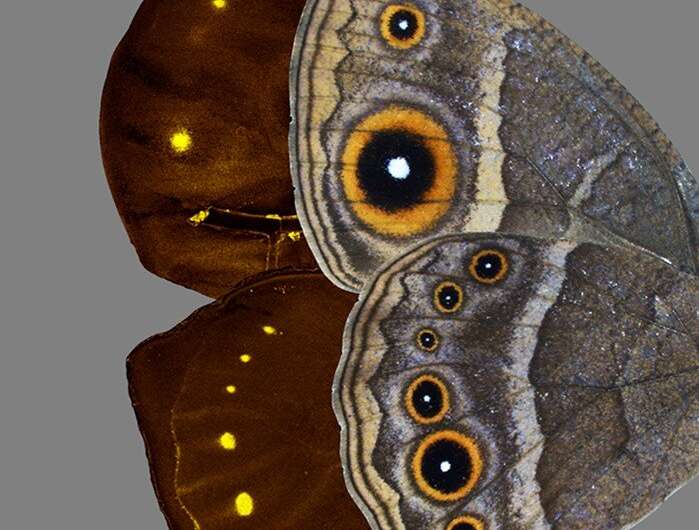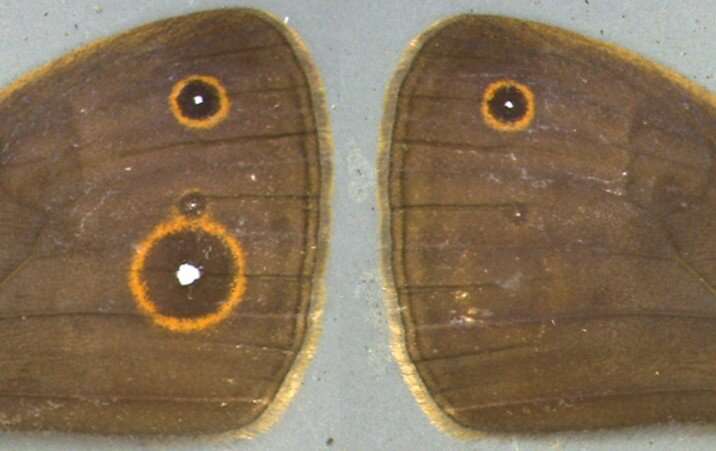Figure 1: The expression of the Hox gene Antennapedia (Ant) during larval wing development maps to the centre of the future adult eyespots in Bicyclus anynana butterflies. Credit: Antónia Monteiro
NUS biologists have discovered that Hox genes are essential for the development of eyespot patterns on the wings of Bicyclus anynana butterflies.
Eyespots are beautiful and important color patterns that help butterflies to evade predation, but their genetic and developmental origins are still poorly understood. Eyespots evolved in the ancestors of a lineage of butterflies around 70 million years ago. They first appeared on the hindwings, and subsequently on the forewings. The genetic and developmental reasons for this unique pattern of deployment have been a mystery. Now, the research team led by Prof Antónia MONTEIRO, from the Department of Biological Sciences, NUS has discovered that two Hox genes, Antennapedia (Antp) and Ultrabithorax (Ubx), are probably connected to the origin of butterfly eyespots on the hindwings and subsequently on the forewings.
Hox genes are a famous set of genes known to give unique identities to regions of an animal's body along the anterior-posterior axis. For instance, they are known to differentiate our forebrain from our hindbrain, and to prevent legs from growing in the abdomen of most adult insects. Although less commonly shown, Hox genes can also lead to the emergence of completely novel traits that appear in unique parts of an animal's body, where the Hox gene is expressed.
Prof Monteiro said, "The African squinting bush brown butterfly, Bicyclus anynana, has eyespots on both the forewings and the hindwings. Two Hox genes are expressed on the wings of butterflies but until now, no one knew about the function of these genes."
Figure 2: The forewing of a Bicyclus anynana butterfly (left) and an Antennapedia (Ant) mutant (right) showing a missing large eyespot, indicating that this Hox gene is essential for eyespot development on the forewings of the butterfly. Credit: Antónia Monteiro
Previous work from her laboratory and others showed that the Hox gene Ubx was expressed homogeneously on the hindwings, but absent from the forewings, whereas the Hox gene, Antp, was expressed in the center of all eyespots during the larval stage (Figure 1).
"The expression of Antp was especially intriguing as this Hox gene is usually absent from insect wings altogether," added Prof Monteiro.
To test the function of both Hox genes in Bicyclus anynana, Dr. Yuji MATSUOKA, a postdoctoral researcher on the team, disrupted their genetic sequence using the CRISPR-Cas9 system. The Antp mutants lost eyespots on the forewings (Figure 2), but lost only the eyespot's white centers on the hindwings. The Ubx mutants showed two types of mutation—some hindwing eyespots disappeared whereas two of the eyespots (those that had forewing counterparts) became larger and acquired the size of the forewing counterparts.
These experiments showed that Antp is essential for the development of forewing eyespots and that Ubx is essential for the development of some hindwing eyespots. Perhaps the co-expression of Antp and Ubx in the other hindwing eyespots can prevent their disappearance when mutations target a single one of these genes. Perhaps, without the initial recruitment of Ubx into the regulation of eyespot development, eyespots might never have evolved on the hindwing. Similarly, without the novel expression and function of Antp, eyespots might never have colonized the forewing.
Dr. Matsuoka said, "This study highlights another example of Hox genes associated with the origin of novel traits, but this is just the tip of the iceberg. How these Hox genes became connected to other essential genes in eyespot development is still unclear, and future work will need to address this genetic mechanism further."
More information: Y Matsuoka; A Monteiro, "Hox genes are essential for the development of eyespots in Bicyclus anynana butterflies" GENETICS Volume 217 Issue 1 iyaa005 DOI: 10.1093/genetics/iyaa005
Journal information: Genetics
Provided by National University of Singapore

























